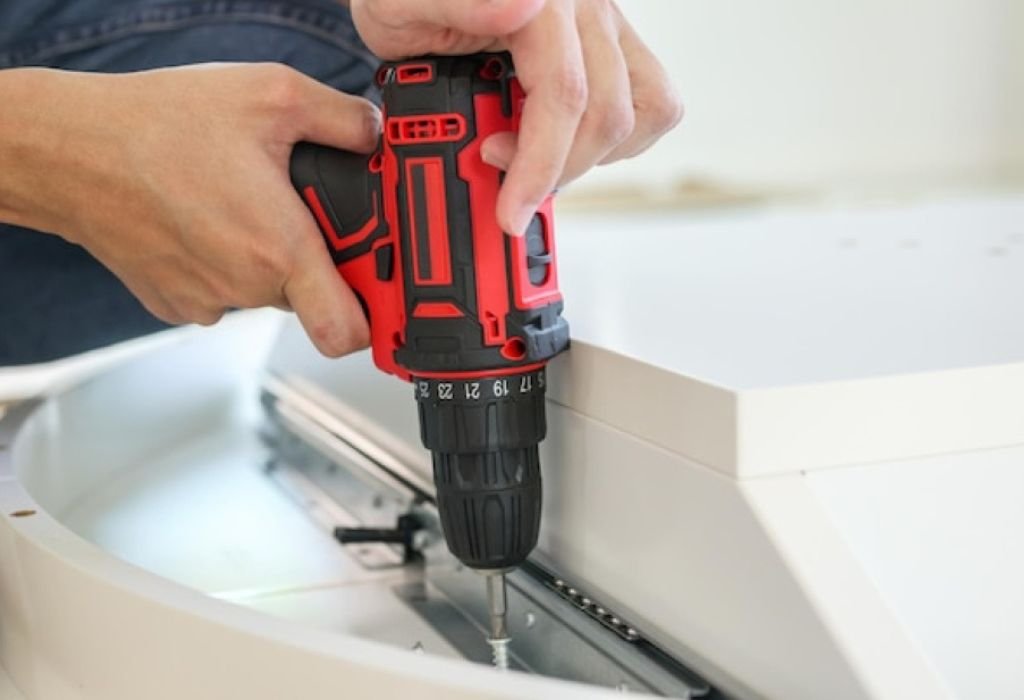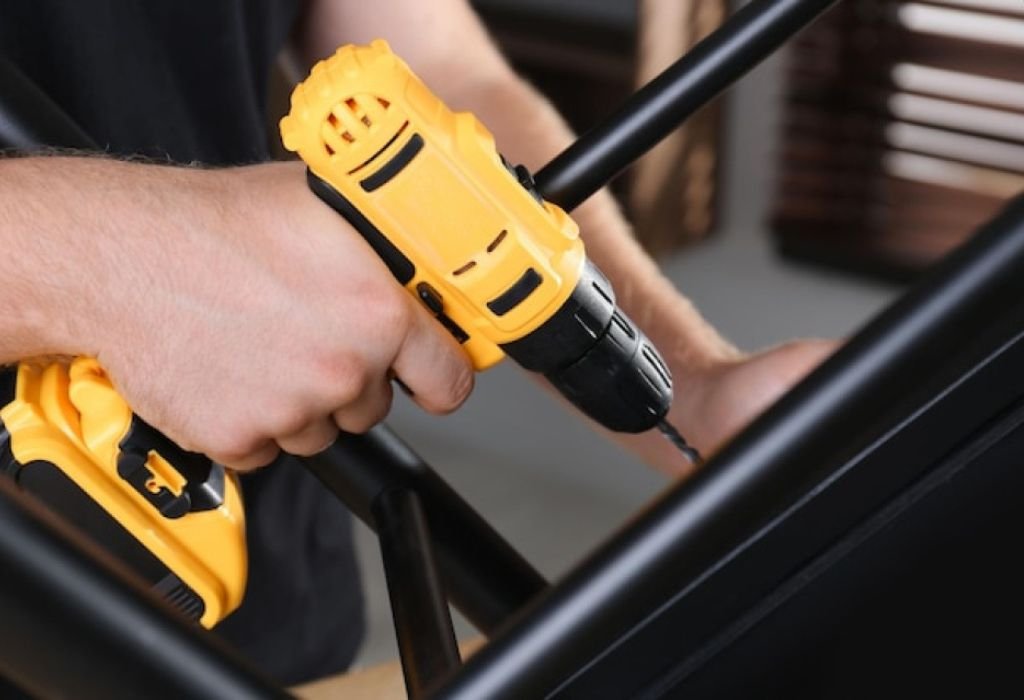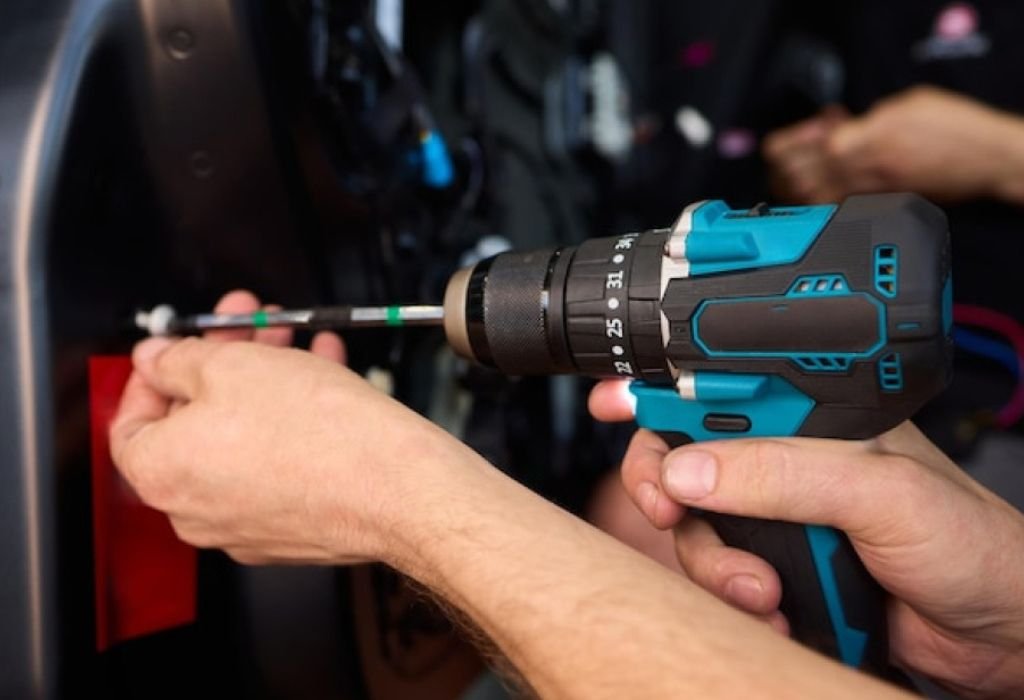A contractor begins building a deck, but the screws resist every turn of the drill.
Progress stalls until a compact tool with a hex chuck impact driver snaps in a bit and drives the fastener flush with ease.
Suddenly, the job moves faster, with less strain on the wrist.
This raises a common question for DIYers and professionals alike: what is a hex chuck impact driver and how does it work?
At first glance, it looks like a small drill, but the secret lies in its quick-change hex chuck and powerful internal mechanism.
The hex chuck, usually 1/4 inch in size, allows for one-handed bit swaps in seconds.
Unlike a traditional drill’s three-jaw chuck, this collet locks hex-shank bits securely in place, making it perfect for repetitive driving tasks (DeWalt).
Inside, a hammer-and-anvil system delivers rapid torque bursts. When resistance builds, the hammer cams back, compresses a spring, and strikes the anvil, sending rotational impacts to the bit.
This action can deliver thousands of impacts per minute, letting screws sink deeper into dense wood or metal without constant wrist strain (Makita).
Impact drivers have become one of the most popular cordless tools on job sites and in home workshops. According to tool industry reports, sales of compact drivers have outpaced standard drills in many regions due to their efficiency and ease of use.
This guide breaks down everything you need to know: what a hex chuck is, how the impact mechanism works, when to use an impact driver over a drill, and what bits and accessories make it most effective.
Quick Answer — What Is a Hex Chuck Impact Driver?

A hex chuck impact driver is a power fastening tool designed to drive screws, bolts, and fasteners with high torque. It uses a 1/4-inch hex quick-change collet that accepts hex-shank bits for fast and secure swaps.
Unlike a drill that relies on constant rotational force, an impact driver adds short bursts of rotational impacts. These torque bursts allow it to sink long screws into tough materials with less effort and reduced wrist strain.
The quick-change hex chuck makes it faster than a traditional three-jaw drill chuck. This feature, combined with the hammer-and-anvil impact system, makes the tool highly efficient for both DIY and professional use.
What makes it a “hex chuck”?
It refers to the 1/4-inch hex collet that locks in hex-shank bits securely.
How is it different from a drill?
A drill uses a 3-jaw chuck and steady torque, while an impact driver delivers impact bursts with a hex chuck.
Is it the same as an impact wrench?
No, an impact wrench uses a square drive for sockets, while an impact driver uses hex-shank bits.
Can it drill holes?
Yes, but only with hex-shank drill bits, not standard round-shank bits.
Why is it popular for fastening?
It delivers high torque in a compact body, driving screws quickly without excessive wrist fatigue.
How the Impact Mechanism Works (Hammer, Anvil, Cam, Spring)
Inside the tool, the motor turns a rotating hammer. As resistance builds, the hammer slips back along a cam, compresses a spring, and then slams forward against the anvil.
This creates a rotational impact that transfers torque directly to the bit. The rapid series of impacts helps break through resistance without stalling the motor.
Because torque is delivered in bursts, the user feels less constant twisting in the wrist. This makes impact drivers more comfortable during long fastening jobs.
Why do screws sink easier with an impact driver?
The hammer-and-anvil system adds momentary torque that overcomes resistance.
Does it vibrate like a hammer drill?
No, an impact driver’s impacts are rotational, not forward-and-back.
Brushless or brushed—does it matter?
Yes, brushless motors increase efficiency and battery life.
Is it safer for the wrist than a drill?
Often yes, since torque is delivered by the tool instead of twisting your arm.
How many impacts per minute does it deliver?
Most cordless impact drivers deliver 2,000–4,000 impacts per minute depending on the model.
What the Hex Chuck Does — Quick-Change, Secure Grip, One-Hand Swaps
The hex chuck is a spring-loaded collet designed to hold 1/4-inch hex-shank bits. It grips bits securely and releases them with a simple pull of the collar.
This design allows one-handed swaps, saving time compared to tightening a drill’s three-jaw chuck. In repetitive tasks, such as driving hundreds of screws, this speed difference is significant.
The chuck also prevents bit slippage by ensuring a tight mechanical lock. This reduces the chance of stripping screws under high torque.
Do all bits fit?
No, only hex-shank bits fit directly.
Can bits pull out under load?
Not if the collet and bit are in good condition.
Are magnetic holders needed?
Optional, but many hex bits and nutsetters are magnetic already.
Can the chuck be damaged?
Yes, debris or worn springs can cause slipping; cleaning and replacement solve this.
Does it support socket adapters?
Yes, with a hex-to-square adapter you can use sockets.
Impact Driver vs Drill — Which Tool for Which Job?
Drills are built for versatility and precision. They create clean holes, handle delicate materials, and accept round-shank as well as hex-shank bits.
Impact drivers excel at fastening. Their high torque bursts make them ideal for deck screws, lag bolts, and self-tapping screws in wood or metal.
For most professionals, both tools are essential. A drill provides precision, while an impact driver delivers speed and power.
Which is better for cabinetry?
A drill is better for delicate, precise work.
Can an impact driver replace my drill?
Not fully. It’s best for driving, not precision drilling.
Do impact drivers have clutches?
Few models do, so drills remain better for fine torque control.
Which tool is better for DIY?
A drill for general work, an impact driver for heavy fastening.
Are combo kits worth it?
Yes, many brands sell drill + driver kits for complete coverage.
Bits and Accessories — Impact-Rated Matters

Impact drivers require impact-rated bits designed with torsion zones to absorb shocks. Standard bits may snap under repeated impacts.
A starter kit should include Phillips, Torx, square drive, nutsetters, and a hex-to-socket adapter. These cover most construction and automotive fastening tasks.
Hex-shank drill bits allow light drilling, but for precise or large holes, a standard drill is more suitable.
Can impact bits be used in a drill?
Yes, but not the other way around.
What size is the collet?
Most use the 1/4-inch hex standard.
Do I need special drill bits?
Yes, use hex-shank bits for impact drivers.
Will cheap bits work?
Not for long; impact-rated bits last longer.
Do sockets fit?
Yes, with an adapter.
Real-World Use Cases — Wood, Metal, Automotive, DIY
In woodworking, impact drivers shine on framing, decking, and long screws into dense lumber. They reduce cam-out and prevent wrist fatigue.
In metalworking, they handle self-tapping screws and sheet metal fasteners efficiently. The impacts help prevent bit walking.
In automotive repair, they can drive light bolts and screws using socket adapters. For lug nuts, however, a true impact wrench is required.
Deck screws or lag bolts?
Impact drivers excel at both.
Sheet-metal screws?
Yes, they work well with the right bits.
Lug nuts on cars?
No, use an impact wrench.
DIY projects like shelves?
Yes, they speed up assembly.
Furniture flat packs?
Yes, with care to avoid overdriving.
Pros and Cons of Hex Chuck Impact Drivers
Pros: high torque, compact size, quick bit changes, reduced wrist strain, and excellent performance on tough fasteners.
Cons: requires hex-shank bits, louder than drills, fewer speed options, and less precision for delicate tasks.
Choosing between them depends on your work. For heavy fastening, impact drivers win. For drilling holes or precision work, drills remain essential.
Why is my driver so loud?
The hammer-anvil action naturally makes noise.
Why does it stop and click under load?
That is the hammer striking the anvil.
Can it drill tile or concrete?
No, use a hammer drill or rotary hammer.
Is it beginner-friendly?
Yes, it’s easy to use once you learn bit swapping.
Are brushless models worth it?
Yes, they last longer and use less power.
Buying Guide — Specs That Matter
When buying, check for brushless motors, multiple speed modes, and compact design. High impacts per minute (IPM) improve performance.
Battery platform compatibility is important. Buying within the same brand’s system saves money and increases versatility.
Also look for ergonomic grips and durable hex collets for daily use.
What torque rating matters most?
Focus on IPM and efficiency, not just max in-lbs.
Do all brands use the same hex size?
Yes, 1/4-inch hex is the standard.
Is variable speed important?
Yes, it helps adapt to different fasteners.
Are compact models weaker?
Not always; many compact drivers are powerful.
Do kits include bits?
Some do, but often bits are sold separately.
Safety, Care, and Maintenance

Always seat bits fully before use. Loose bits can slip or break under impacts.
Clean the hex chuck regularly to remove debris that may cause jams. Inspect and replace worn bits promptly.
Wear hearing and eye protection, as impact drivers are louder and can throw debris.
Why do bits snap?
They may not be impact-rated or are misused at angles.
Collet won’t release?
Relieve torque and pull the collar fully.
Is lubrication needed?
Follow brand guidance, usually light maintenance only.
Should gloves be worn?
Yes, gloves protect from vibration and debris.
How long do impact bits last?
Quality impact-rated bits last far longer than standard ones.
Future Trends — Smarter Drivers and Better Bits
Manufacturers are adding assist modes that automatically adjust torque for screws and bolts. This reduces overdriving and stripping.
Bit technology is improving with torsion zones, coatings, and longer lifespans. Expect better durability in future sets.
Compact brushless models continue to dominate, delivering more power in smaller, lighter bodies.
Will impact drivers replace drills?
No, both tools are needed.
Are bits getting better?
Yes, new torsion designs last longer.
Will hex chucks change size?
No, the 1/4-inch hex standard will remain.
Are smart features common?
Yes, premium models already include them.
Will they get quieter?
Some improvements are being made, but impacts are naturally loud.
Conclusion
So, what is a hex chuck impact driver? It is a compact, high-torque fastening tool with a 1/4-inch quick-change hex chuck and a hammer-and-anvil mechanism that delivers rotational impacts.
It outperforms drills in driving screws and bolts, especially in wood and metal. However, drills remain better for precision hole-making and clutch-controlled work.
The best setup is having both tools. Use a drill for delicate or precision tasks and an impact driver for tough, repetitive fastening. Together, they cover nearly every job in woodworking, construction, and DIY.

I’m John F. Nicholas, the founder, lead writer, and drill enthusiast behind 101drill.com. With years of hands-on experience in power tools and DIY projects, I created this platform to share practical knowledge, expert tips, and real-world insights to help others master the art of drilling.
